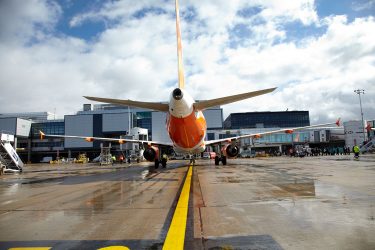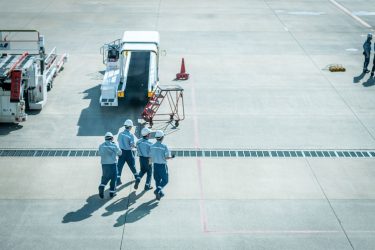Predicting 2020 trends and disruptors for the aviation industry
- Like
- Digg
- Del
- Tumblr
- VKontakte
- Buffer
- Love This
- Odnoklassniki
- Meneame
- Blogger
- Amazon
- Yahoo Mail
- Gmail
- AOL
- Newsvine
- HackerNews
- Evernote
- MySpace
- Mail.ru
- Viadeo
- Line
- Comments
- Yummly
- SMS
- Viber
- Telegram
- Subscribe
- Skype
- Facebook Messenger
- Kakao
- LiveJournal
- Yammer
- Edgar
- Fintel
- Mix
- Instapaper
- Copy Link
Posted: 28 February 2020 | Tara Nolan (International Airport Review) | 1 comment
This roundtable reviews 2019, makes predictions for 2020, and provides exclusive advice for airports from four industry leaders.


For the first edition in International Airport Review’s magazine series of 2020, we spoke to a few of our prestigious advisory board members for a review of 2019, predictions for 2020, and exclusive advice for airports.
Participants:
  |   |   |   |
| Angela Gittens, Director General, ACI World | Chris Woodroofe, COO, Gatwick Airport | Maurice Jenkins, Director Information Systems and Telecommunications, Miami Dade County | Fred Lam, CEO, Airport Authority Hong Kong |
How would you review the progress the aviation industry has made in 2019?
Gittens: Focusing on airports, I think we’ve made great strides in facing up to the environmental challenge. We were all struck by the IPCC report at the end of 2018, showing just how fast climate change is happening. We thought our targets up to this point were pretty ambitious, arguably even difficult for airlines and airports to achieve, but it’s clear now that they are simply not enough. As an industry, we need to be even more ambitious.
Woodroofe: At an industry level, it’s been a challenging year, in which two very high-profile issues – aircraft safety and airline insolvency – have had a significant impact on aviation and other related sectors.


The target to hit net-zero carbon emissions by 2050 is another major challenge that also went to the top of the news agenda. This is, undoubtedly, one of the most important issues we face, as an industry and a planet, and there is an increasingly broad agreement that we need to achieve it. Along with many others, I am increasingly optimistic that this target can be met, but only following significant innovation, investment and, of course, ambition from leaders across our industry.
Jenkins: In 2019, we’ve seen a growing strength in public-private partnerships, with stakeholders working together to explore new technologies that can help eliminate manual, paper-laden processes while enhancing security.
In many areas of the world, airports are now implementing kerb-to-gate solutions for a seamless experience. This approach has forever transformed the industry and will become the standard in a few years.
New airport construction projects are taking advantage of new technologies to revolutionise the airport experience, transforming the airport to become the destination. In 2019, Changi, Istanbul, Dubai and Abu Dhabi unveiled the results of ambitious programmes that unify visitors’ aspirations for community, culture, commerce and travel.
The U.S. is a slightly different picture. Here, the most recent airport was built in 1995 and many airports have been described by ACI as ‘terminally challenged’ – often constrained by accelerated growth, lagging technology investment and funding restrictions. In 2019, many airports begun expansion, renovation and construction projects, creating the opportunity to modernise and transform the traveller experience. Whether we will see such an ambitious ‘mega-airport’ in the Americas remains to be seen.
LAM: In 2019, Asia led the rapid growth of the aviation industry as the region continued to tap into its potential for development, especially in fast-growing markets such as China and India. Over the past year, we have seen major investments in almost all major airports in Asia and also those in emerging markets. China continued to commission new airports in 2019, including the Beijing Daxing International Airport, which houses the largest airport terminal in the world. China alone plans to build 200 more airports by 2035.
At Hong Kong International Airport (HKIA), we are also pressing on with projects to expand our core passenger and cargo service capacity for the long term as the region’s major hub, including expanding HKIA into a three-runway system which will enable us to handle more than 100 million passengers a year.


Hong Kong’s Skycity
Looking ahead at 2020, does your organisation have a particular focus?
Gittens: ACI Europe has set a goal of net-zero emissions by 2050. We are currently preparing for a study looking at developing a worldwide goal. Different countries, different regions even, are all at different stages. Taking one region’s template and transplanting it into every other region, will not work. The aim of the study is to establish a feasible but ambitious goal, and to set out how we’re going to be able to accomplish it.
Naturally, our focus will remain on safety and security – the number one for aviation. We cannot exist as a form of mass transportation without it. Customer service will also continue to be a key issue for us, with major programmes as requested by our members.
As airports become more business-like, customer focus becomes ever more important, which has driven a demand for benchmarking and for sharing best practice. We have developed a professional customer experience certification programme where our individual employees complete a curriculum and provide coursework on providing good customer experience, which has seen a very fast uptake.
Woodroofe: For Gatwick, this year is very much about preparing and consulting our plans to bring our Northern runway into regular use. If we get planning permission, the runway would be used by smaller aircraft for departures only, and this sustainable level of growth would come on stream incrementally over time.


Jenkins: Our goal is to make Miami the global airport of choice with a world-class experience. In 2019, we served more than 46 million travellers, and we expect that to grow to more than 77 million by 2040.
Central to our vision is investing in technological services that can be shared across all services via our core common-use technology platform as the optimum way to ensure continuity of experience throughout the airport.
In 2020, we will continue to focus on the exploration of technologies that support our vision and growth objectives, building upon existing infrastructure investments. Biometrics, automation and operational intelligence are core areas of technological exploration that we will continue to invest in as ways to drive growth and innovation for the industry.
Lam: In the year to come, we will be reaching important milestones for our major development and expansion projects, all of which aim to upgrade customer experience at HKIA. For instance, the first hotel in our major commercial development, SKYCITY, is scheduled to open in 2020/21 – which will also be the third hotel at HKIA – while construction for the SKYCITY entertainment, retail and dining complex is currently underway. Meanwhile, our Sky Bridge, which is a world-record-breaking footbridge across the apron, is scheduled to open in mid-2020. As we entered 2020, we began rolling out a series of new F&B offerings, with online food pre-ordering set to be introduced to make it even more convenient for passengers. This year we are also transforming the design and configuration of all boarding gates, introducing different themes and experiences, as well as further streamlining the boarding process with the implementation of facial recognition technology.


What do you predict the biggest disruptor will be in the coming year?
Gittens: I think technology, for all its positives, more often than not proves disruptive, especially in the beginning. Drones, in particular, are likely to be our biggest disruptor. Commercial aviation needs to figure out how we are going to share the airspace, manage safety, security and congestion and produce regulations that can keep pace with the constant development of this technology.
If you don’t develop your staff, you can only stay on your current trajectory – and that trajectory is going to change
I think 2020 is going to see a convergence on this matter. This is going to be the year where the industry, governments and regulators have to decide how to deal with this issue. What is out there? Who’s doing what? Are they even aware of the systems, processes and procedures that govern the use of airspace? We often think of air as unlimited, but this is far from the truth.
Woodroofe: As someone responsible for the airport’s stable operations, I think the British weather will continue to be the biggest disruptor to Gatwick, particularly when combining the impact of big and small weather events over the course of a year.
I suspect, however, the question is about other types of disruptors and, for this, I would say that AI, machine learning and automation will have a big impact across the industry. These technologies are already having an impact, but I expect the role they play in airports will only increase. We already use AI and machine learning to help our planes depart on time, and automation will increasingly help us to reduce queues and improve security.
Jenkins: Ignoring the political landscape (Brexit, U.S. elections, etc), and focusing on technology, we can see that the adoption curve is continually accelerating. As we move into 2020, the first generation of ‘digital natives’ are now entering the workforce and becoming the voice of the consumer. Self service, automation and personalisation are key imperatives. These include the generation of social media, crowdfunding and the sharing economy.
The movement toward cloud-based infrastructure, shared data services and collaboration frameworks is driving a shift in how we think about operational management and design. This requires increased priority on security, privacy and standards to support global interoperability and responsible use.
Connectivity-dependent technologies – such as AI, machine learning, IoT, mobility and blockchain – are beginning to mature as key enablers for the digital experience, enabling airports to take advantage of the various data sources at its disposal to create improved, personalised experiences and more autonomous operational management. The ‘digital twin’ concept is maturing as the expected model reference for data visualisation and operational intelligence, offering retrospective, as well as predictive, analysis capabilities. This requires ready access to many data sources and the ability to decipher ‘truth’ from the disparate sources of data to support decision-making capabilities.
In 2020, blockchain will finally begin to emerge with practical applications that add value to the enterprise – less emphasis on the mystique of the technology and more focus on the business proposition.
Lam: A 5G network would be a game changer. Airport Authority Hong Kong is putting in place enterprise 5G infrastructure at HKIA to ensure that there will be full coverage at the airport for both passenger and operational needs. With the high data transmission rate and low latency of 5G, we aim to build a massive IoT network, collecting real-time data of various operations at the airport to further enhance our productivity and resource deployment efficiency. With 5G, we will also be able to drive many more innovation projects at HKIA, such as the use of autonomous electric tractors airside.
Sustainability and passenger experience are, of course, two topics all airports are addressing. What else would you suggest airports must concentrate on in the coming year?
Gittens: Airport operators need to think beyond the coming year and invest in their staff. Change is coming in every area – environment, safety, security, sustainability, customer experience, competitiveness, infrastructure development and so on, and airports need to ensure that their members of staff are ready and adaptable to that change.


Woodroofe: It’s a broad term, but I think it’s important to keep a focus on innovation, particularly new technologies.
Airports are complex operational environments with numerous stakeholders often working to achieve disparate objectives. Airport innovations can help us all work better, easier and more efficiently together, which ultimately makes for a better experience for our passengers.
Jenkins: Our vision is to continue a tradition of leadership in balancing environmental, social and economic factors in our development practices. Achieving sustainability objectives and improving customer satisfaction and experience are natural results of our focus on achieving operational excellence. Miami International Airport has been closely involved in projects that support collaboration among all stakeholders and finding ways to improve efficiencies that create a positive impact for travellers, employees, the community and the environment.
Lam: The application of AI and data analytics in airport operations is crucial. Data analytics and intelligence applications are increasingly useful for unveiling patterns, and tracking and predicting development trends, all of which contribute to effective decision-making, resource planning and service improvement. Here at HKIA, we partner with local and overseas tech companies and institutions to tailor initiatives that best fit our unique environment and operational needs. Apart from driverless tractors, other operational aspects – such as airfield ground lighting inspection and passenger baggage trolley count – also benefit from the application of AI.
If you had to give one piece of advice to airports today, what would it be?
Gittens: Simply – invest in your staff, because things are not going to stay the same. If you don’t develop your staff, you can only stay on your current trajectory – and that trajectory is going to change. It’s got to change.
Woodroofe: I’d say prepare to manage the unexpected.
By definition this is a difficult task and I’m sure that all airports are very aware that they might have to do this at some stage.
For me, it is about having plans in place to cover a wide range of possible scenarios, but also making sure that any playbook of contingency plans is flexible enough to cover the unexpected.
Jenkins: My one piece of advice to airports today would be that you don’t need to set up an R&D group or a lab to effectively drive innovation. Give yourself room to experiment, run trials and, most importantly, create measurable KPIs that help you understand and align with business objectives. As you evaluate how the technology helps achieve those goals, you will get invaluable customer feedback that helps you refine your approach and achieve the best results for your environment and business needs. Having a strong technology partner that understands your business and supports an adaptive approach with the right enabling technologies is imperative. Remember that innovation is a continuous process and worth the dedication and effort to better ensure success, learning and preparation for growth.
The technology adoption curve is accelerating faster than ever, and the first generation of ‘digital natives’ are becoming the new consumers. They demand an emphasis on always on, always ready, connected, personalised services that allow them to experience travel in new ways that we’ve not seen before. The onus is on us to keep up.
Lam: Despite the many infrastructure and technology developments, at the end of the day, an airport is all about the people who run it. Talents are indispensable for the sustainable growth of an airport. Airports should look into the nurturing of talents for its long-term development. At HKIA, we established our own aviation academy four years ago and an exchange programme with other hub airports. We are also actively engaging our stakeholders and business partners to share our visions and ensure that, together, we build a stronger community at the airport.
Issue
Related topics
Air traffic control/management (ATC/ATM), Airport development, Capacity, Information technology (IT), Runways and pavements, Sustainability, Sustainable development, Workforce
Related airports
London Gatwick Airport (LGW), Miami Dade International Airport (MIA)



















“you don’t need to set up an R&D group or a lab to effectively drive innovation. Give yourself room to experiment, run trials and, most importantly, create measurable KPIs that help you understand and align with business objectives. ”
Excellent advice from Mr. Jenkins in this times where the industry face uncertainty economic growth.